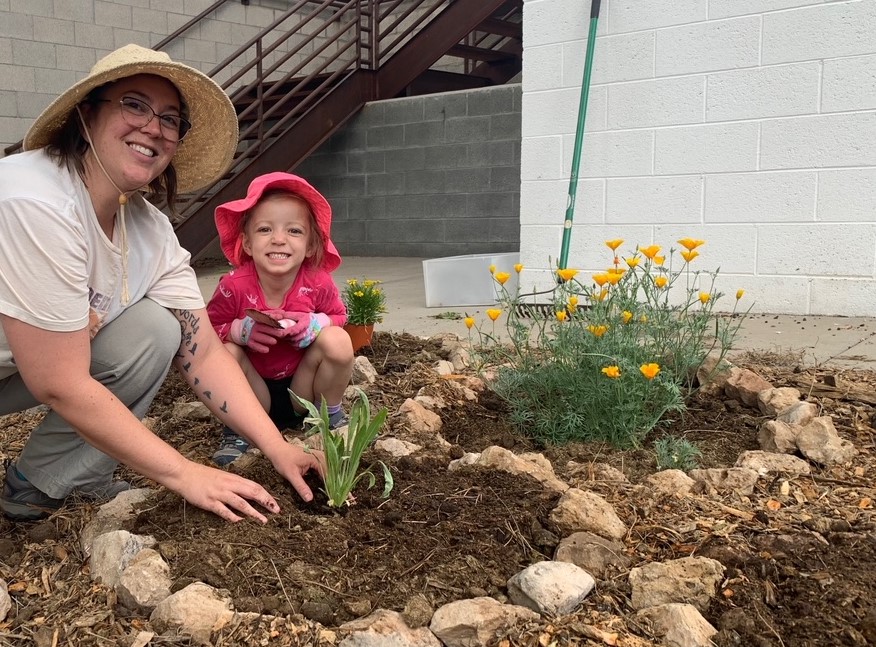*Editor’s Note: The “Views from NAU” blog series highlights the thoughts of different people affiliated with NAU, including faculty members sharing opinions or research in their areas of expertise. The views expressed reflect the authors’ own personal perspectives.
By Janan Scott
Financial Oversight Analyst, Senior for the Economic Policy Institute
Scott is a Coconino Master Gardener residing and gardening in Flagstaff. Her favorite genus of flower is the penstemon, and she has a soft spot for paper wasps.
“If you can garden in Flagstaff, you can garden anywhere!” I’ve heard this adage from several gardeners over the years. While I can’t speak to the definitive truth of it, I can say that I agree with the base meaning. If you can successfully garden in Flagstaff, you’ve embraced trial and error. You understand that failure can lead to wisdom when you move past the initial disappointment of your loss. You’re not afraid of making mistakes.
I didn’t get into gardening until I moved to northern Arizona, so I don’t know any difference, but I’ve heard enough complaining from my out-of-state transplant friends to understand how comparatively challenging it is. We have a short growing season (approximately 105 days, give or take depending on your neighborhood), unpredictable summer weather (hello, hail in July!), poor native soil and dramatic temperature swings between day and night. It’s … a vibe.
In the spirit of spring and the promise of warmer days ahead, I’d like to share the three rules that have led to my own successes in the garden, making the aforementioned challenges a little easier to combat.
Be observant
Before starting your garden, observe the location—which areas get the most and least amount of sunlight throughout the day, where does water go when it rains, what kind of wildlife visits? This initial observation allows you to customize your garden design and get ahead of challenges within your control. Very sunny locations might benefit from strategically placed trellises to create afternoon shade for plants that like to keep cooler. If rain pools in certain areas of the yard, you might consider creating swales to improve drainage, or digging these areas out a little and installing rain gardens. If you observe signs of pocket gophers or prairie dogs in the area, it’s probably a good idea to line the bottom of your raised beds with mesh wire before filling them in with soil to prevent an underground attack.
Once you have started your garden, spend time in it! Check in every day and observe how everyone is doing. Check the soil for moisture, pull up weeds, scan the plants for signs of pests or disease. Frequent observation can lead to early intervention when problems occur, which increases your chance of success. Observe the life in your garden. Take note of the insects and birds that visit and be sure to give them water.
Be resourceful
Water is a resource. Information is a resource. Manure is a resource. One of my favorite things about gardening is that it rewards resourcefulness and makes you truly appreciate your resources. Consider implementing water-wise techniques such as drip irrigation and ollas to maintain consistent soil moisture without wasting water. Utilize the educational resources available to you—there are so many just waiting to be discovered! Most cities, including the City of Flagstaff, have pages on their websites dedicated to local gardening education and resources. Reach out to friends of friends to acquire cheap or free materials like wood chips, manure and heirloom seeds. While it’s certainly possible to spend thousands of dollars installing your garden, it’s not necessary when you leverage your available resources.
Be generous
When we think of generosity, we often think of money. While there are several gardening organizations and projects worthy of financial support, the generosity I’m referring to is of a different variety—time, food and space. Some of my fondest gardening memories have come from time spent volunteering. Volunteering at community gardens or public land weed pulls is a great way to meet other gardeners that you can learn from. There is something about people coming together to achieve a common goal not because they have to but because they want to that just feeds my soul. Time is valuable, so why not use it to create some garden magic?
If you’re a gardener, you’ve likely had an abundance of something at the height of the growing season—tomatoes, kale, zucchini (probably zucchini, so much zucchini). If you find yourself overflowing with produce, be generous and share the wealth. Whether sharing with family, friends, colleagues or neighbors, everyone can benefit from fresh, home-grown vegetables.
Lastly, be generous with the life that visits your garden and give it space. I’ve dedicated a third of my small home garden to native plants to support our local pollinators. If a paper wasp nest pops up in a location that won’t interfere with my daily activities, I leave it be. Creepy-crawlies like spiders and centipedes aren’t my favorite, but I understand the role they play in my garden ecosystem, so I leave them alone. I recognize that my garden is not just mine, so I give space to the beneficial visitors.
Yes, gardening in Flagstaff can be challenging. But these challenges have humbled me, made me more comfortable with loss and deepened my connection to nature. While it’s true that we sometimes have snow in summer, we also have abundant sunshine and ample gardening resources. You’d be surprised to learn just how far those things can take you.
Happy gardening!




